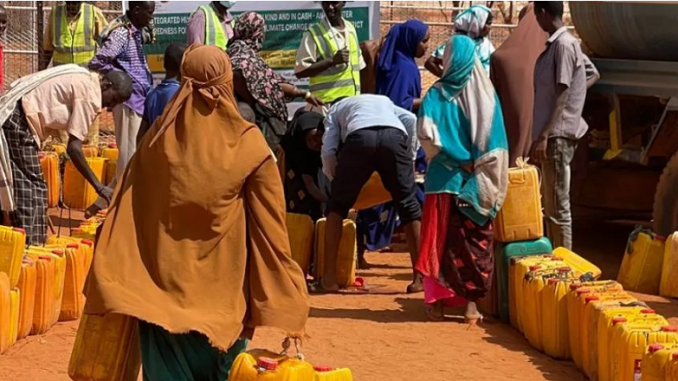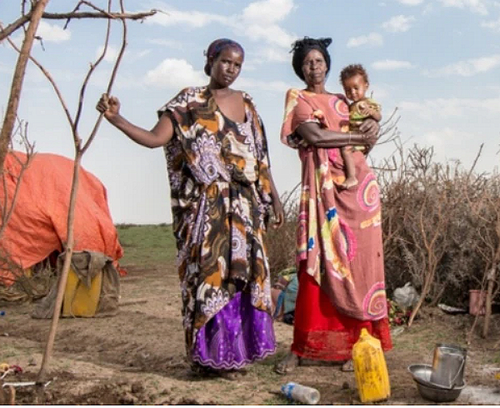
DUBLIN, Ireland, April 21, 2022 (ENS) – Trucking water into communities who are somehow surviving the drought gripping the East African country of Somalia, has got Ireland’s largest aid organization Concern Worldwide ringing loud alarm bells – warning that hundreds of thousands of Somali residents could die without urgent humanitarian intervention.
“It is too late when children start dying from severe malnutrition and disease,” said Abdi-Rashid Haji Nur, Concern Worldwide’s Somalia Country Director.
He blames climate change.
“Concern is in areas that have a very high risk of famine declaration and where parents struggle to find enough clean water and food for themselves and their children. They come to Concern and its partner-run nutrition clinics with emaciated babies in desperate need of support,” Abdi-Rashid explained. “This drought, which we believe is linked to climate change, effects the entire Horn of Africa region.”
Even with the Equator running through the southern part of the country, Somalia is suffering its worst drought in many years. Add ongoing conflicts as well as rising fuel and food prices, made worse by Russia’s invasion of Ukraine, as both countries supply grains and cooking oils to the world, and prices are soaring.
USAID, an agency of the United States government, and a supporter of Concern Worldwide, says, “Since 1991, Somalia has essentially been a collapsed state and has experienced chronic food insecurity, widespread violence, and recurring droughts and floods. The social costs of war have been enormous, leaving Somalia with some of the lowest human development indicators in the world. “
In the 2021 Global Hunger Index that measured food security in 135 nations, Somalia ranked last. The hot dry country has seen many livestock deaths as pasture and water have vanished and agricultural land has became unusable due to the drought.

The United Nations Office for the Coordination of Humanitarian Affairs, OCHA, is worried too, warning that by summer 350,000 of the 1.4 million severely malnourished children in Somalia may die if nothing is done to help them now.
The country is so dry that the Juba and Shabelle Rivers have barely any water left. The alluvial plains of the Juba and Shabelle have in the past been described as the breadbasket of Somalia, and over the last 20 years, much has been done by humanitarian and development agencies to restore Somalia’s collapsed water systems, but more needs to be done.
“If it doesn’t rain by the end of April, and Somalia still doesn’t have sufficient financial aid to help the 4.5 million people impacted, then the situation will deteriorate and a famine may be declared in some regions,” Abdi-Rashid warned.
“Right now, there are over 700,000 people who have had to leave their villages, some travelling for days in severe heat, to reach urban centers where they think they can access support,” Abdi-Rashid said.
But the world is not stepping up to donate as it has in the past. Just four percent of the US$1.5 billion (€1.3 billion) that the United Nations says is needed to respond to Somalia’s crisis has been donated by governments.
Concern’s Regional Director for the Horn of Africa, Amina Abdulla, takes a broader view. She warns that the current drought crisis “has quickly eroded the resilience capacities of communities not just in Somalia but across the Horn of Africa region.”

Famine and Thirst Felt Across Central Africa
The Horn of Africa is parched and hungry, it’s true, but the drought damage this year is not limited to that region. It stretches far to the west.
Seven other countries strung across the width of Africa in a line just north of the Equator – Burkina Faso, Cameroon, Chad, Mali, Mauritania, Niger and Nigeria – are experiencing drastic food and water shortages, too.
For the first time, acute food insecurity in the region is stretching beyond the Lake Chad region to hit coastal countries on the Gulf of Guinea like Benin and as far west as Sierra Leone on the Atlantic Ocean.
For the third consecutive year, the countries of the Sahel and West Africa are facing a food and nutrition crisis of exceptional proportions. Acute food insecurity almost quadrupled between 2019 and 2022, from 10.8 million to 40.7 million people respectively, with millions more at risk of slipping into a crisis situation or worse.
The UN Food and Agriculture Organization, FAO, has joined with the international community in calling for urgent scaling up of emergency assistance and strengthening the resilience of vulnerable people and agrifood systems in the Sahel, the vast semi-arid region of Africa between the Sahara Desert to the north and tropical savannas to the south, and also in the Lake Chad region.
On April 6, a special high-level pledging meeting on “Food and nutrition crises in the Sahel and Lake Chad regions: time to act now and better mobilize in Sahel and West Africa for the future” was co-organized by the Sahel and West Africa Club, the European Union and the Global Network Against Food Crises, co-led by FAO.

Pledges totaled around €1.79 billion against a Humanitarian Appeal for the entire Sahel and West Africa region of €3.8 billion. This includes an additional €67 million in humanitarian assistance announced by the European Union, bringing its total contribution for the affected countries in the Sahel and Lake Chad regions to €240 million in 2022 so far.
The European Union has also set aside €654 million for 2021-2024 to provide a long-term development assistance response to the structural food crisis in the seven most affected countries.
This situation is a result of long-term issues – poverty, a lack of availability and access to basic social services and protracted insecurity.
Recent socio-economic shocks, extreme weather events, and the impacts of COVID-19, the atypical increase of prices of basic food commodities and the very serious consequences of the war in Ukraine, are all worsening the food and nutrition situation.
These converging and compounding shocks could cripple gains and lead to further cascading humanitarian needs.
Laurent Thomas, FAO Deputy Director-General, said at the pledging meeting, “Any delayed response will have massive consequences and a severe cost for the future in a context where more than 30 million of Sahelians are already considered on the verge of starvation, with potentially 11 million more as of June this year.”
“Significant efforts are needed to provide an immediate response but also to address the root causes of this crisis, otherwise levels of acute hunger will continue to rise,” he said. “Countries of the Sahel region need to invest in making agrifood systems more efficient, inclusive, resilient and sustainable.”
“With the increased of cost of food, the ones expected to suffer the most are the already most vulnerable for whom food represents the largest share of the budget of the family,” Thomas said. “We should also not underestimate the consequences the spike increase of the cost of fertilizer will have on yields and local food production availability.”
“There is absolute urgency to re-invest in local food production together with humanitarian food assistance and safety nets,” Thomas said. “Investing in saving agriculture livelihoods today means saving lives of millions tomorrow.”
Featured image: Somali residents line up to fill their water jugs from a Concern Worldwide water truck. February 2022 (Photo courtesy Concern Worldwide)



